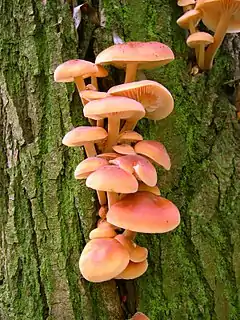Enokitake
Enoki (Flammulina velutipes), also known as velvet shank, is a species of edible mushroom in the family Physalacriaceae. It is well-known for its role in Japanese cuisine, where it is also known as enokitake (榎茸, エノキタケ, Japanese pronunciation: [enoki̥ꜜtake]).[1]
| Enokitake | |
|---|---|
 | |
| Wild enokitake, Flammulina velutipes | |
 | |
| Cultivated Flammulina velutipes | |
| Scientific classification | |
| Kingdom: | |
| Division: | |
| Class: | |
| Order: | |
| Family: | |
| Genus: | |
| Species: | F. velutipes |
| Binomial name | |
| Flammulina velutipes | |
| Synonyms | |
| |
The mushroom naturally grows on the stumps of the Chinese hackberry tree (Celtis sinensis) and on other trees, such as ash, mulberry and persimmon trees. Enoki can be sourced September- March and has been named winter fungus due to its seasonality. Wild forms differ in color, texture, and sliminess and may be called futu, seafood mushrooms, winter mushrooms or winter fungus, velvet foot, velvet stem or velvet shank.[2]
Features
There is a significant difference in appearance between the wild and cultivated types of the mushroom. Cultivated mushrooms have not been exposed to light, resulting in a white color, whereas wild mushrooms usually display a dark brown color. Cultivated mushrooms are grown in a carbon dioxide (CO2)-rich environment to nurture the development of long thin stems, whereas wild mushrooms produce a much shorter and thicker stem.
When picking it in the wild, it is important not to confuse it with the poisonous Galerina marginata. Flammulina velutipes can be distinguished by its shiny and sticky caps, white spores, and the absence of a ring on the stem. Galerina marginata presents brown caps and stipe and most notably has brown, rusty spores. It also tends to grow isolated and it presents a ring.
Commercially farmed enoki is a long, thin white mushroom and is a popular ingredient for soups, especially in East Asian cuisine, but can be used for salads and other dishes. The mushroom has a crisp texture and can be refrigerated for approximately one week. This shape is due to a CO2-rich atmosphere used in farming.[3] The farmed form is also known as golden needle mushroom, futu mushroom or lily mushroom. The farmed F. velutipes is sold both fresh and canned.
Names
| Flammulina velutipes | |
|---|---|
float | |
| gills on hymenium | |
| cap is convex | |
| hymenium is adnexed | |
| stipe is bare | |
| spore print is white | |
| ecology is saprotrophic | |
| edibility: choice | |
The names enokitake (榎茸、エノキタケ), enokidake (榎茸、エノキダケ) and enoki (榎、エノキ) are derived from the Japanese language. In Mandarin Chinese, the mushroom is called 金針菇 (jīnzhēngū, "gold needle mushroom") or 金菇 (jīngū, "gold mushroom"). In India it is called futu, in Korean, it is called paengi beoseot (팽이버섯) which means "mushroom planted near catalpa", and nấm kim châm in Vietnamese. In Hungary it is called téli fülőke, meaning "winter ear".
Varieties
Two new varieties of F. velutipes are described by scientists on morphological grounds in 2015.[4] They have further proposed in 2018 that F. velutipes var. filiformis, the Asian enokitake, should consitute a separate species F. filiformis on phylogenetic grounds.[5]
The west American variety F. velutipes var. lupinicola has also been proposed to form its own species.[6] As of 2020, both new species are recognized to MycoBank, Index Fungorum, and the NCBI taxonomy tree.
Food and components
Flammulina velutipes is edible, but may have a soft or slimy texture.[7] Enokitake mushrooms contain ergothioneine and terpenes.[8][9]
See also
References
- Dictionary.com (2012). "enokitake". Dictionary.com. Dictionary.com, LLC. Retrieved 14 May 2012.
- Shanghai Xuerong Biotechnology Co Ltd on Seafood Mushrooms
- Yan, Jun-Jie; Tong, Zong-Jun; Liu, Yuan-Yuan; Li, Yi-Ning; Zhao, Chen; Mukhtar, Irum; Tao, Yong-Xin; Chen, Bing-Zhi; Deng, You-Jin; Xie, Bao-Gui (25 November 2019). "Comparative Transcriptomics of Flammulina filiformis Suggests a High CO2 Concentration Inhibits Early Pileus Expansion by Decreasing Cell Division Control Pathways". International Journal of Molecular Sciences. 20 (23): 5923. doi:10.3390/ijms20235923. PMC 6929049. PMID 31775357.
- Z.W. Ge, Kuan Zhao & Zhu L. Yang (2015). "Species diversity of Flammulina in China: new varieties and a new record". Mycosystema. 34 (4): 600. doi:10.13346/j.mycosystema.150080.CS1 maint: uses authors parameter (link)
- Wang, Pan Meng; Liu, Xiao Bin; Dai, Yu Cheng; Horak, Egon; Steffen, Kari; Yang, Zhu L. (September 2018). "Phylogeny and species delimitation of Flammulina: taxonomic status of winter mushroom in East Asia and a new European species identified using an integrated approach". Mycological Progress. 17 (9): 1013–1030. doi:10.1007/s11557-018-1409-2. S2CID 49299638.
- Hahn, C. 2016. Bestimmungsschlüssel zu ausgewählten Gattungen der Agaricales 2: Die Gattung Flammulina. Mycologia Bavarica. 17:7-24
- Meuninck, Jim (2017). Foraging Mushrooms Oregon: Finding, Identifying, and Preparing Edible Wild Mushrooms. Falcon Guides. p. 118. ISBN 978-1-4930-2669-2.
- Bao HN, Ushio H, Ohshima T (November 2008). "Antioxidative activity and antidiscoloration efficacy of ergothioneine in mushroom (Flammulina velutipes) extract added to beef and fish meats". Journal of Agricultural and Food Chemistry. 56 (21): 10032–40. doi:10.1021/jf8017063. PMID 18841979.
- Fukushima-Sakuno, Emi (2020-07-30). "Bioactive small secondary metabolites from the mushrooms Lentinula edodes and Flammulina velutipes". The Journal of Antibiotics. 73 (10): 687–696. doi:10.1038/s41429-020-0354-x. ISSN 0021-8820. PMID 32733077.
External links
 Media related to Flammulina velutipes at Wikimedia Commons
Media related to Flammulina velutipes at Wikimedia Commons
